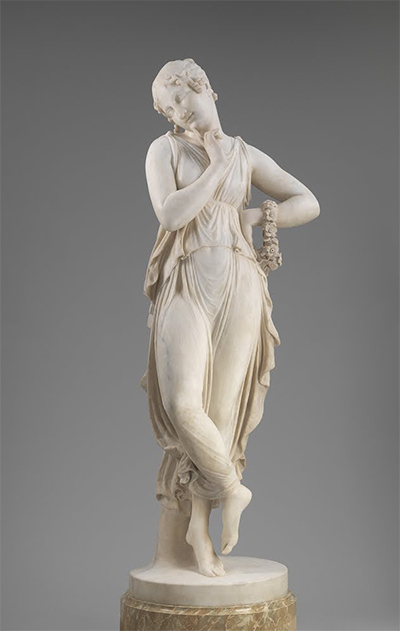At a height of almost seventy inches (a hundred and seventy-seven centimetres), this charming sculpture, Dancer With Finger on Chin by Antonio Canova, exemplifies the nineteenth century's fixation with classical representations of the female form.
Carved in marble between 1819 and 1823, the dancer is transformed into a goddess in gossamer, but with a more knowing and coy expression than would generally be found in Greek mythology. Canova is well-known for his sculptures of nudes, and although Dancer With Finger on Chin is clothed, the flimsy material of her dress clings to her shape, suggesting the lightness of the fabric. He followed the trend of the time, with his statues marking a return to a simpler, more streamlined classical style, after the fussiness of Baroque, but still managing to combine the best features of both.
A Venetian born in 1757 to a father who made a living as a stonecutter, and with a grandfather who was a stonemason and a sculptor, it's not surprising that Antonio Canova displayed the same skills. However, he took his art to another level, and by 1775, he had his own studio. Around 1780 he moved to Rome, where he studied the works of Michelangelo. This would have given him an insight into how to portray the human form, while he was also greatly influenced by the ancient classical works all around him. He would have seen many statues similar to Dancer With Finger on Chin, but was able to put his own individual slant on it, bringing it up to date.
Although he didn't take pupils, Canova paid workers to carry out the early carving on each piece, using his method that enabled them to replicate the plaster form in a marble block. A veil was placed over the statue so that he could concentrate on its surface, while others were present to read appropriate literary and historical works to him. Following the fashion at the time for torchlight viewing of galleries at night, Canova used candles to display his statues, and indeed, worked on them in these conditions, too. This helped him to soften the surfaces, and he would also rub them with pumice stones for long periods, sometimes finishing with lead and rottenstone, and applying patina to lighten the skin areas.
Antonio Canova was secure enough to be able to offer financial help to students just starting out, or to send patrons to young sculptors, such as Sir Richard Westmacott and John Gibson. His significance was diminished during the Romantic period, but the importance of his place between the last classical movement and modern interpretations is now recognised. Dancer With Finger on Chin, now in the National Gallery of Art in Washington DC, portrays all this perfectly.




